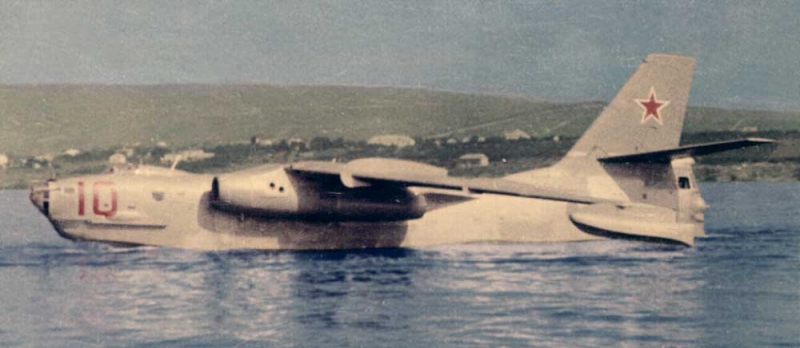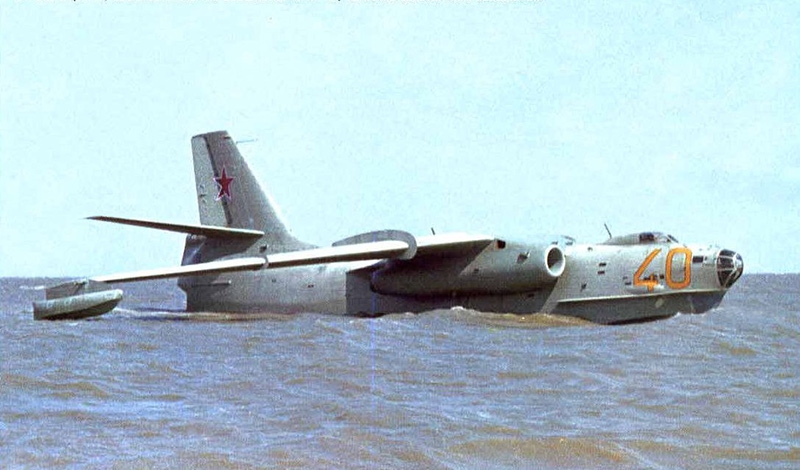
Be-10 - Soviet jet seaplane (flying boat). Created in OKB Beriev. The first flight made 20 June 1956 of the year. The plane demonstrated on air display in Tushino 1961 year. Be-10 was built in a small series 1956-1961, total issued 27 machines. On this plane has been established 12 world records, including speed record for seaplanes - 912 kmh, not beaten till now.
Was-10 – video
The plane was not adopted by the, However, in the years 1959-1963 limited operated aircraft Black Sea Fleet (977-and OMDRAP, from 1961 year - the 318th separate regiment of marine anti (OMPLAP).
AT 1968 by Be-10 finally decommissioned.
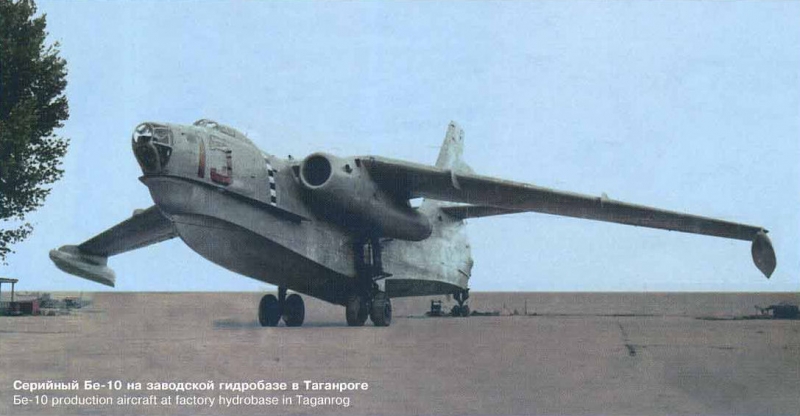
Serial Be-10 to the factory in Taganrog gidrobaze
The first domestic jet seaplane P-1 due to problems of weight and did not go into a series of, and the only built car was broken in the mid-fifties. Nevertheless, problems with the first draft of a flying boat with jet engines could not be a valid reason for termination of the work in this direction. Command of the Navy required to develop a new seaplane for naval aviation. Thus began the history of the project Be-10, during which there had been some progress. In particular, new aircraft, Unlike his predecessor,, yet reached the mass production and operation of the troops.
In early autumn, 1953 of the year, when the military refused to further support the P-1 project, commander of naval aviation EH. Transfiguration took the initiative to develop a new seaplane. The proposal supported the Commander of the Navy NG. Kuznetsov. The result was a decision of the Council of Ministers №2622-1105ss, has withdrawn 8 October 1953 of the year. In accordance with this document Taganrog DB-49, led by GM. Beriev, It was to develop a new jet seaplane called Be-10. This machine was designed for reconnaissance in the interests of the Navy, strikes on shore facilities and enemy ships using torpedoes and bombs, Fitting sea mines, etc..
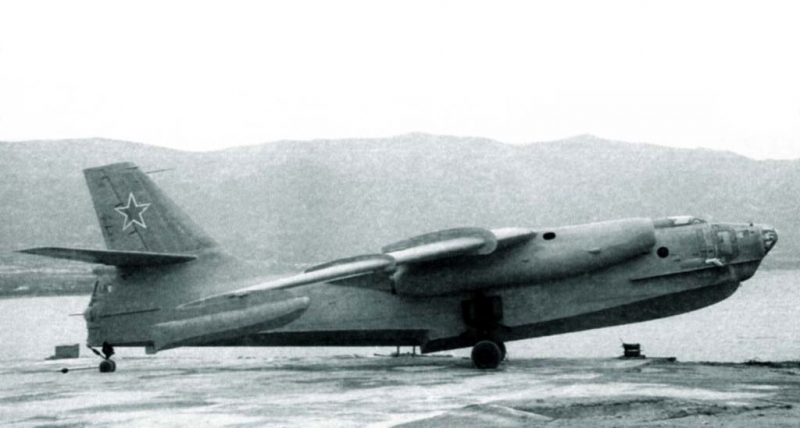
First jet seaplane development OKB-49 does not fully match the customer's requirements, which was one of the main reasons for the cessation of work on it. Despite this, Requirements to Be-10 were significantly higher, than P-1. Maximum speed was set at the level of 950-1000 kmh, range - not less 3000 km, practical ceiling - not less 12-14 km. Takeoff and landing required to carry out under wind 20 m / s and the wave height and 1,5 m. The first prototype flying boat Be-10 was supposed to go to trial in November 1955 of the year. Later it supposed to build a second prototype, able to take off as the water, and with ground airfields.
The new project of Be-10, received the OKB-49 designation of "M", It was of great importance for developers. After the failure of the project P-1 was required necessarily to develop and bring to production new seaplane. In case of repeated failures could follow respective orgvyvody, until the dissolution of the design bureau. Therefore, the OKB-49 employees began to use all the experience and actively involve adjacent research organizations.
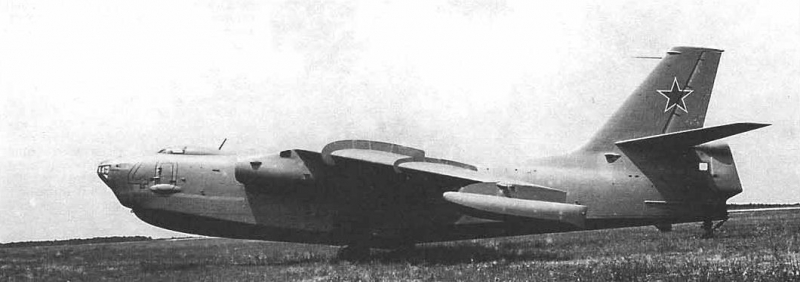
Be-10 on chassis erratic. Before the flight to establish speed records bryzgootrazhatelnye guards dismantled
The first reactive seaplane P-1 had a big problem with the design of the fuselage-boat and its behavior during the takeoff run. Fortunately, correcting the identified deficiencies have been associated with research weight, which to some extent eased the process of creating a new airplane. Nevertheless, the development of the body had to spend a lot of research and testing. Initially offered several options for the design of the hull, which were tested in the waterway TSAGI. Then there were the new models are made for tests in the mouth of the Don River. There's also been tested and large model, which was towing a torpedo boat. Due to such a long and complex work could work out the basic features of the fuselage-boat and to ensure acceptable performance.
Already at the stage of preliminary work revealed some problems, related to aerodynamics and layout. So, calculations showed, that the rejection of external suspension arms will increase the maximum flight speed of about 100 kmh. Besides, internal deployment of weapons allowed to protect it from various unfavorable factors. However, the creation of such gruzootseke was extremely difficult. The required load can be placed just inside the fuselage-boat. Consequently, it was necessary to develop a large sealed hatch, closing the cargo hold and withstand the stresses arising during the run-up and run. These units have been developed for the first time in the world.
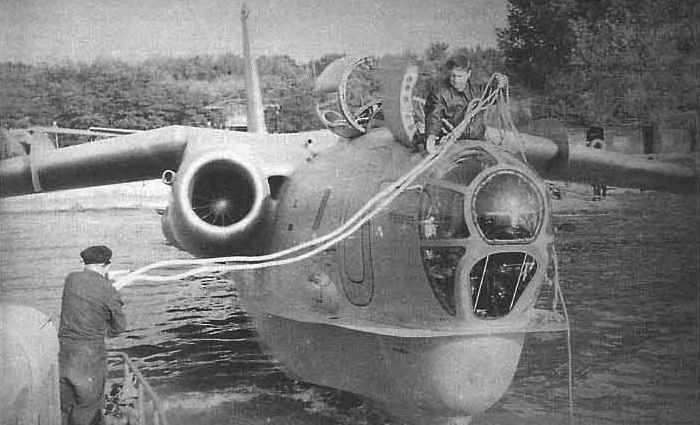
Record Be-10 before towing to start
Enough problems with the overall shape of the car. according to the calculations, It should be three times larger weight takeoff from the previous P-1. more weight, more powerful engines, internal gruzootseke and other original proposal accordingly affected the complexity of the project. The situation is complicated by the fact, that the number of OKB-49 staff left much to be desired. To facilitate the development of GM. Beriev organized ad hoc group under common species brigade, headed by AG. Bogatyrev. The group gathered 20 specialists from all parts of the design bureau. Due to the complexity and secrecy of the work group were placed in a separate room, which was one of the reasons colleagues specific relation. Among desk staff spread opinion, that the new group is not actually engaged in anything, and its members "were at the resort". As a result, the group came up with the name, nickname "Sochi-Matsesta".
Nevertheless, employees, included in the special group, not rested, and we are doing very important things. In a relatively short period they formed the main features of appearance perspective hydroplane Be-10, which later formed the basis for the project. Already by mid-May 1954 It has been prepared preliminary design, and in early June, it completed the construction of the layout of the new aircraft. By this time, the glider was built for static tests. Besides, in the early summer of the 54th kicked off the construction of the first prototype, destined for flight tests. The construction of airplanes and gliders for the tests was involved the plant №86 (g. Taganrog). At this enterprise we have built flying boat Be-6, therefore, the OKB-49 and the plant had the experience of fruitful cooperation. Nevertheless, plant and was so loaded with orders, because of which the construction experienced the Be-10 came with enough high rates.
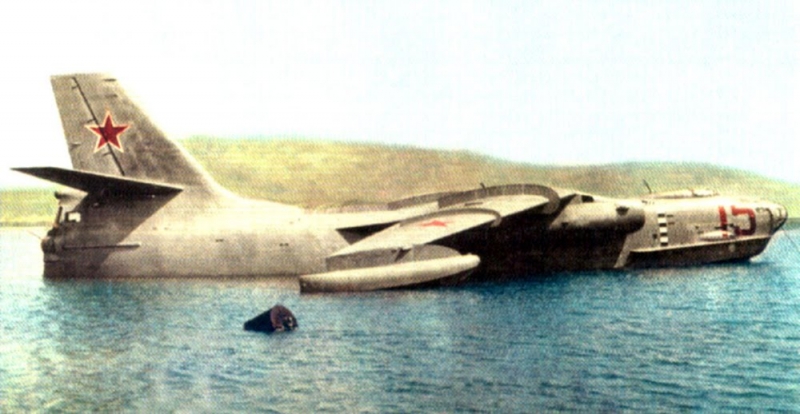
The first serial Be-10, involved in state tests
In spite of the problems that arise, hydroplane Be-10 first prototype was completed in October 1955 of the year. Now you can start testing the new car in the Council of Ministers established terms. However, aircraft manufacturers are faced with serious problems of climatic nature. Traditionally, a platform for testing the OKB-49 aircraft was the water area of the Gulf of Taganrog. However, in late November or early December, the bay was covered with ice, because of what had to stop testing until March or April. For example, when the aircraft tests R-1 had to make two winter break. Back in the late forties, began the search for a new site for testing without any interruption. AT 1949 by GM. Beriev found convenient bay near Gelendzhik, where previously located military unit, from which there remain some infrastructure, including gidrospusk aircraft. For approval it took several years, because of what the new testing facilities has started only 1955 year. In mid-November Be-plane 10 in a partially disassembled immersed in a special dock and taken to Gelenjik. 20 December started the first factory test.
Be-10 was an all-metal flying boat with vysokoraspolozhennym swept wing. It should be noted, in the guise of the machine discern some features, characteristic of the later OKB-49 seaplanes, although there are some differences, associated with the accumulation of experience in the establishment and operation of such equipment.
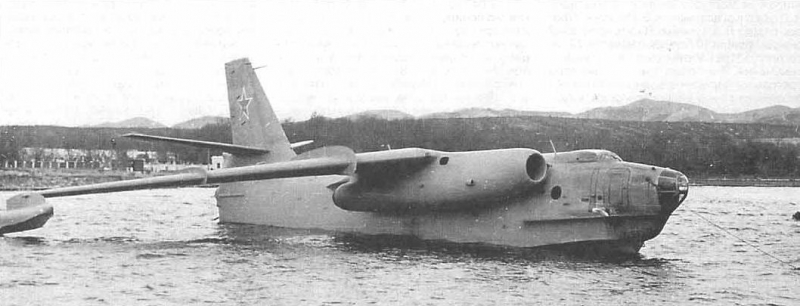
BE-10 with modified air channels nacelles, took part in the joint control tests
Seaplane hull has a boat-length 31,45 m. The lower part of the fuselage was made on the basis of 77 frames, coupled stringers and lining. The internal volume of the fuselage were separated bulkheads with watertight doors into nine compartments. It provides buoyancy of the aircraft in case of damage and filling the two compartments with water. Bow and stern compartments designed to accommodate the crew and carried tight. general ideas, implemented in the design of the cockpit of the Be-10, They were borrowed from a flying boat P-1. So, the pilot and navigator were located in the two bow cabins and had to fall into place through a hatch in the left side. Emergency evacuation of the airplane by means of ejection seats used by top hatch of the navigator and pilot lights resettable. Gunner-radio operator was located in the rear cockpit and had his own side door. Bailout arrow produced through a hatch in the bottom.
inside the fuselage, for Redan, It was gruzootseke for transportation of payload. To load bombs or mines proposed to use a hatch in the deck (in the center section) Aircraft. Used for load shedding airtight hatch at the bottom bicuspid. Besides, in the bottom of boats envisaged three hatch for cameras, used in exploration.
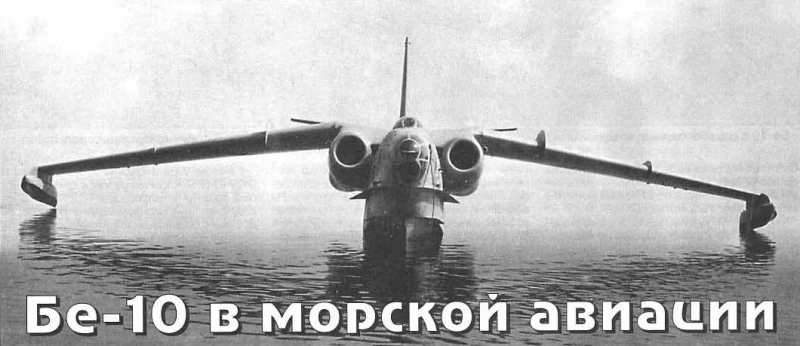
Be-10 was the first Soviet seaplane with swept wings. This flying boat received a cantilever wing span 28,6 m area 130 quarter. m and swept 35 °. The wing was performed on a "gull" with a small cross-V center-consoles and negative V. The power set of wings - dvuhlonzheronnoe caisson. On the upper surface of each arm includes two aerodynamic ridge. On the wingtips mounted floats streamlined. Mechanization of the wing was odnoschelevyh retractable flaps and ailerons.
The aircraft also had swept tail unit with the stabilizer, mounted on the keel. Leading edge sweep was keel 35 °, Stabilizer - 40 °. Plumage performed by dvuhlonzheronnoe scheme stressed skin.
aircraft control system was built on the basis of hard wiring. Any boosters absent, but to reduce the load on the controls applied spring servo tab and trimmers. All control surfaces were supplied with electric trimmer. In the case of the elevator trim cables electrical system duplicated. Under the bottom there was a steering wheel to control the motion of the water, connected to the wiring of the rudder on the tail.
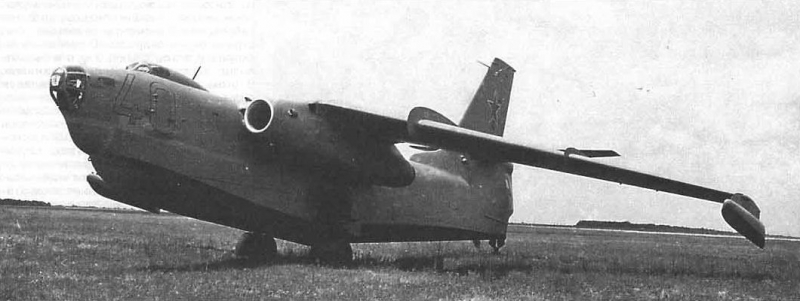
Record Be-10, which happened to fly and pilots 318th OMPLAP
Under the center of the aircraft, on the fuselage sides, We had two nacelles. engine air intakes were made before the front edge of the wing, and the exhaust pipe were installed to collapse outwardly, in order to avoid damage to the engines of the aircraft tail gases. To protect against water splashes on the nacelles had a set of special boards. On gondolas buildings were folding panels, Provides access to the units, and serves as a platform for technical personnel when servicing the aircraft on the water.
Be-10 was equipped with two turbojet engines AM-7 on the draft 7350 kg. Engines komplektovalisy turbostarterami. As a part of the fuel system had 16 neprotektirovannyh soft wing tanks. As the fuel tanks were filled with a neutral gas generation. Compressors, engines have been equipped with air-conditioning system for the selection of crew cabs.
As a seaplane, Be-10 could independently carry out a number of operations, peculiar to the courts. To this end, it was equipped with a bottom and two drogue, anchor winch, cat, pumps, etc.. Besides, on board there was a rescue inflatable boat. In this way, crew could put a seaplane anchorage, make minor repairs and perform other operations.
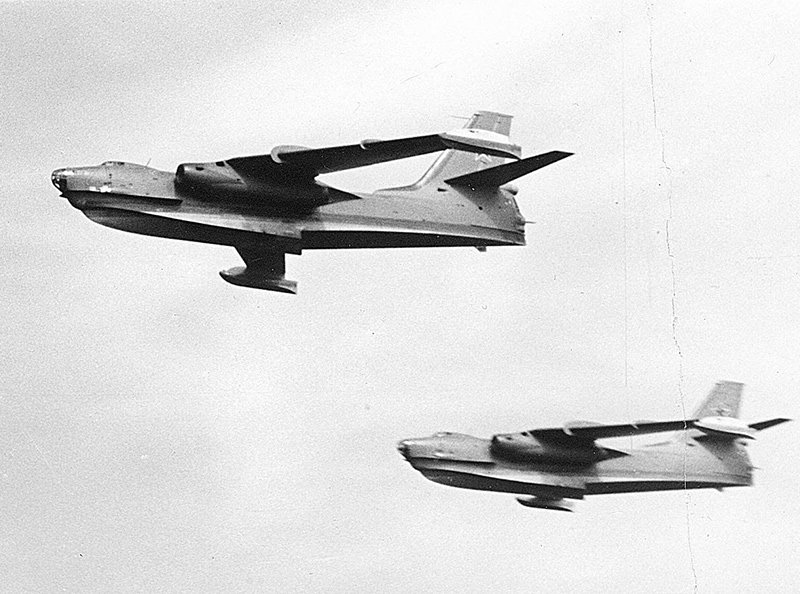
The forward fuselage provided space for the installation of two automatic guns NS-23 caliber 23 mm. Two more guns were placed on the aft installation, Managed gunner-radio operator. Aft turret controlled using PKC-sighting station 53 and "Argon" radar sight.
Normal aircraft useful load was 1500 kg. In overweight he could carry up 3300 kg bombs, or torpedo min. Be-10 could carry and apply to 20 aviabomb calibration 100 kg, two bombs Brabo-1500, two or three torpedoes PAT-52, or the same amount of minutes AMD-2M, or up to four minutes, the TMP-500M. For aiming at a bombing in the cockpit of the navigator had sight OPB-11C. Download the payload was to be made through the top (the water) or lower (on the ground) Luke.
To search for surface targets aircraft carrying the radar "Kurs-M". Besides, it is equipped with radio compass ARK-5, radio altimeters, radio stations, equipment identification "Silicon-2, as well as other flight-navigation systems. At the bottom of the boat there was a system for mounting various types of aerial cameras. Before shooting, the bottom opens a small hatch, and the installation of a camera is shifted to a vertical position.
New seaplane receive significantly larger and heavier than its predecessor. His normal takeoff weight reached 45 t, maximum - 48,5 t. Empty weight of the aircraft - 27,64 t. Volume of tanks allowed to carry up to 18,75 m and kerosene oil. according to the calculations, seaplane cruising speed equal Be-10 800 kmh, maximum (on high 5000 m) should reach 910 kmh. Practical ceiling - 12 km. Maximum range was supposed to reach 3150 km, Practical was slightly less 2900 km.
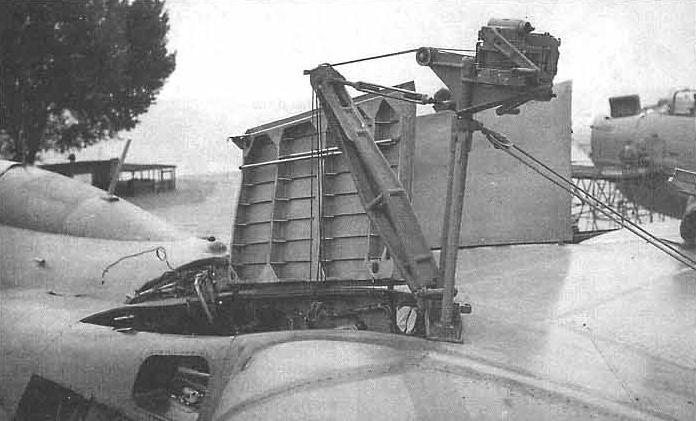
To replace the engine on the Be-10 used a special winch
The basic version of the flying boat offered to equip the removable wheel carts, intended for launching and exit of the land. One pair of removable wheels installed under center, the second - in the fuselage tail.
Factory tests of the new aircraft launched 20 December 1955 of the year. Already at the first turn on the first engine design problems have been identified. Because of the jets engines tail of the car started to vibrate, because of what a few details cracks and loosen some of the nuts. It was necessary to modify the design of the nacelle, increasing camber engines, as well as to strengthen some elements rear fuselage.
Flying the new aircraft began 20 June 1956 of the year. For the first time the Be-10 took off running test pilot VV. Kuryacheho. 20-minute flight went well, but landing the plane began to Barca and lost the lower hatch radio operator-gunner. Starting from the second flight, the commander of the crew of testers became GI. Buryanov, who held the post until the end of production tests. Until mid-December 1958 year experienced the Be-10 is 76 flights with total duration of more than 83 hours.
20 July 1959 year state tests came just two hydroplane Be-10: experienced and the first serial number 8600101. The prototype was used to determine the flight characteristics and seaworthiness, and with the help of the serial were tested weapons and various on-board equipment. For several months the two aircraft flew a total of nearly 230 hours.
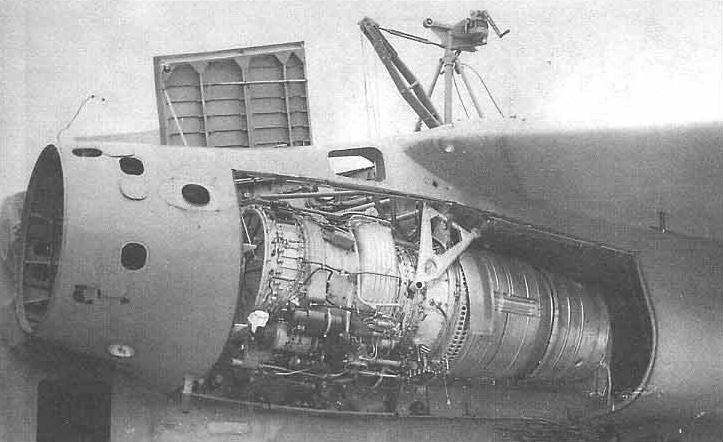
Everything is ready for the dismantling of the Be-10 engine
According to the results of state tests hydroplane Be-10 is recommended for adoption by the Navy aviation. Nevertheless, It noted, that the plane does not fully comply with the requirements of the customer. For example, top speed was 40 km / h lower than the lower limit, specified technical task, practical range did not reach the required almost 100 km, a service ceiling was less than desired to 1,5-2 km. The main reason for this was considered insufficient production characteristics of AL-7, which were lower than claimed. Besides, the reason for the claim was the TBO engine only 40 hours.
In several problems were identified during testing, related to the design of air intakes Aircraft. Their design does not protect the engine from water, and is fired from the guns was a high risk of surge. The experiment showed, what 10 liters of water, caught in an air intake, It was enough to stop the motor. To remedy this shortcoming by seaplane prototype engines installed elongated air channels. New test has demonstrated the correctness of this idea. According to the results of such testing production aircraft number 8600302 I got air channels, extended to 2 m raised to 350 mm air intakes.
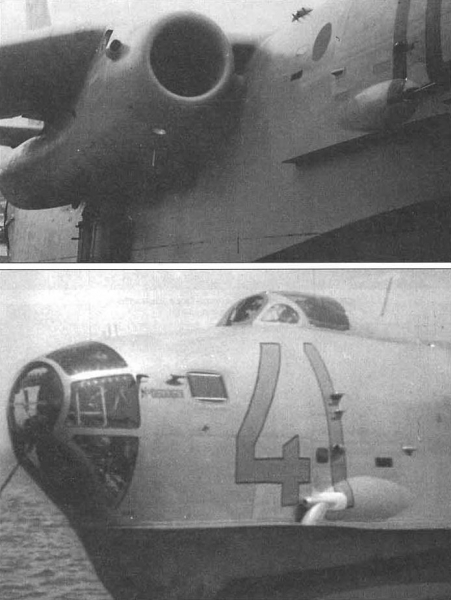
Detail of the bow Experimental (up) and serial Be-10. Clearly the difference in the design of the bow gun mount
Since the end of December 1959 to end of April 1960 , the tests were carried out in such a way modified aircraft. An elongated air inlet effectively protects the motor from water, allowing the take off and land at a wind speed of up to 16 m / s and swell in height and 0,8 m. Besides, surging stopped by firing from nose guns on all flight modes. Nevertheless, these improvements reduced the maximum flying speed, ceiling and range. performance losses were so great, it was decided not to equip production aircraft long air channels. We decided to do a set of flaps, catching splashes.
Test aircraft Be-10 continued until the early sixties, but the decision to start serial production was made in 1957 year. To 1961 , it was built in Taganrog 27 production vehicles of the new model. Notably, that production is constantly changing. So, construction peaked in 1959 year, when the customer handed over 12 new machines. All this type of seaplanes were sent to 977-th separate marine dalnerazvedyvatelny Marine Aviation Regiment, which 1961 It was renamed the 318th separate maritime anti-Aircraft Regiment.
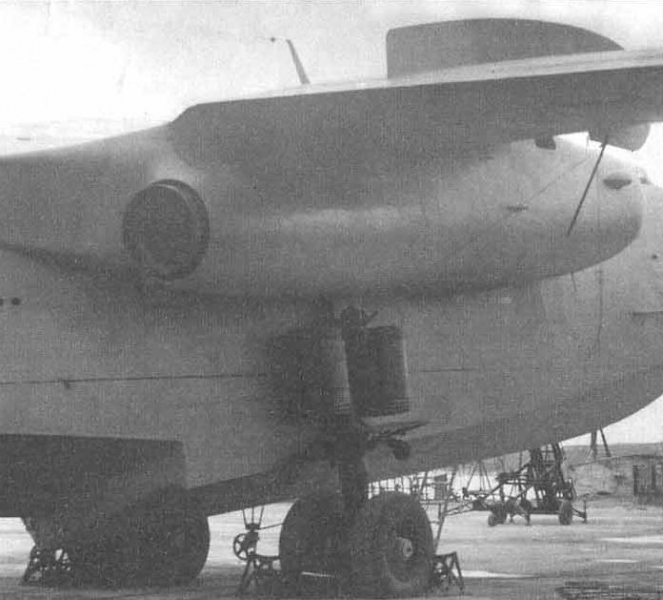
Nacelle and the main pillar of erratic chassis BE-10
On the basis of the Be-10 was planned to create a few special modifications. It is known to develop a set of equipment, which allowed to make a serial seaplane training with additional controls in the cockpit of the navigator. Several such packages were produced, but information about their use of no. AT 1961 year production aircraft number 0600505 lost aft gun mount, instead of which have mounted fairing. In August and September there were several flights, during which crews have installed 12 world records, including for seaplanes (912 kmh) and a height of 15-ton load (11997 m).
One of the serial seaplanes after write-offs involved in an interesting experiment. He was placed on the barrel in Gelendzhik Bay and left for a while. Such a lengthy experiment made it possible to study the effect of sea water on the metal structures of flying boats.
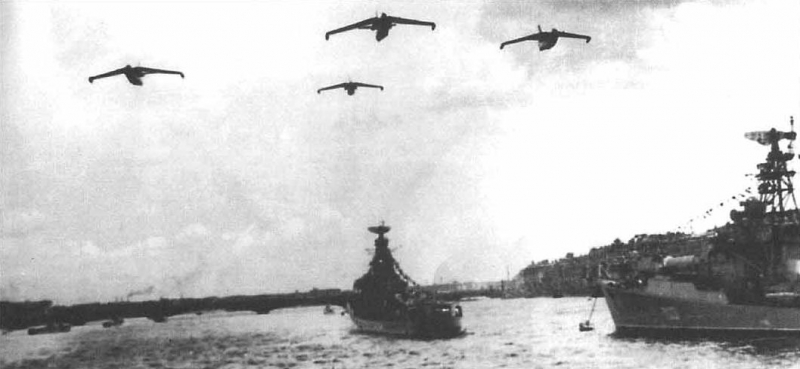
Be-10 from the 318th OMPLAP in the parade on the Neva. Leningrad, August 1961.
In the spring 1958 the DB-49 experts worked on a project-missile aircraft Be-10H. Resolution of the Council of Ministers of №564-275 26 May anti-ship missile project K-12 passed GM Design Bureau. Berievo. With the use of this product, it was decided to do antiship complex K-12B. The basis for it was to be modified hydroplane Be-10. Be-10H project proposed to replace the nose of the aircraft at bay with the necessary equipment, and to abandon the upper and lower hatches gruzootseke. Under the wing of a seaplane had to carry one or two anti-ship missiles.
After all the modifications missile takeoff weight should reach 48,5 t. At the same time the maximum speed was reduced to 875 kmh, and combat radius (one rocket without refueling) equal 1250 km. When refueling from submarines in the open sea plane could carry out combat missions at ranges up to 2060 km from the base. The missile K-12 was supposed to fly at a distance of up to 110 km and deliver a nuclear warhead to the target or high-explosive fragmentation warhead with 216 kg of explosive.
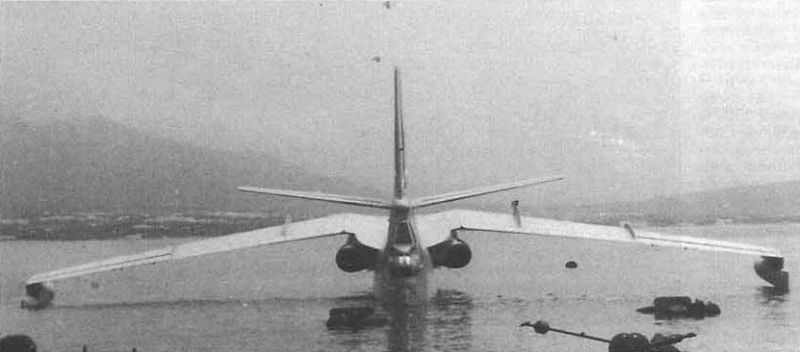
Was-10 – on the barrel prior to starting of engines
10 June 1959 , the preliminary version of the draft K-12B and Be-10N was approved by the aviation industry leadership. Development of the project continued, but it was stopped in the summer 1960 of the year. The proposed aircraft missile had several serious problems, hindering its use in a real war. At first, he was an easy target for enemy fighters, and secondly, needed refueling from submarines. During refueling seaplane and the supernatant submarine risked being discovered and destroyed. Besides, refueling was only possible at a low agitation, which also made it difficult to combat work. The result of the discussion of this problem was the decision of the Council of Ministers on 12 August 1960, stops all work on the aircraft Be-10H and missile K-12.
AT 1961 It took place the first demonstration of a new seaplane public. Four cars took part in the celebrations, dedicated to Russian Navy Day, and flew over Leningrad. Several Be-10 also participated in the air parade in Tushino.
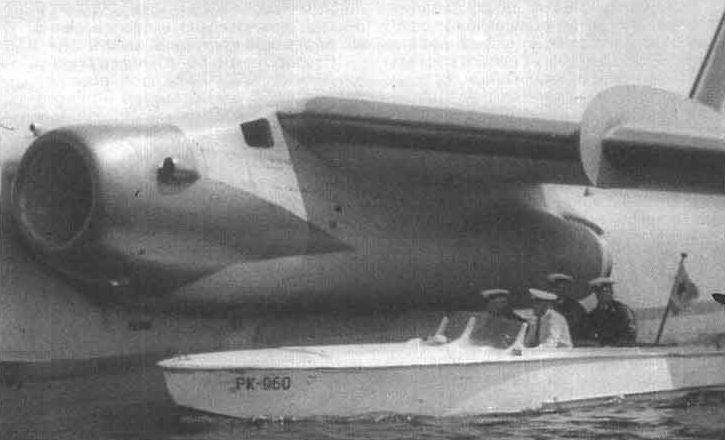
To display the parades leading edges of the wings and tail, as well as the nose of the nacelle Be-10 were painted red
For several years, the Be-10 jet seaplane was only a part of aviation of the Navy of the Soviet Union. Despite this, Navy commanders soon disappointed in him. The plane had an insufficient engine power, its structure was subject to corrosion, and seaworthy characteristics have serious implications for application flexibility. Therefore, 1964 years of naval aviation command supports the proposal to stop the use of available Be-10. Over time, the naval aviation in fact abandoned the technology, and aircraft stood idle on the shore. Only in 1968 , the Commander of the Navy SG. Gorshkov approved the proposal of Air Command.
All Be-built 10 aircraft were decommissioned and scrapped. According to some reports, two cars for some time kept at the Taganrog plant №86, one of them was planned to make a monument. Nevertheless, these plans have not been implemented, and both went to the airframe utilization. To date, not kept any hydroplane Be-10.
Although it is not too long operation, is not accompanied by specific successes, hydroplane Be-10 has an important place in the history of the Soviet / Russian and world aviation. He became the first commercial flying boat with turbojet engines. Besides, This aircraft set 12 world records, part of which was maintained for a long enough time. very disappointing, that unique and interesting from a technical and historical point of view, the aircraft was only in photos and drawings.
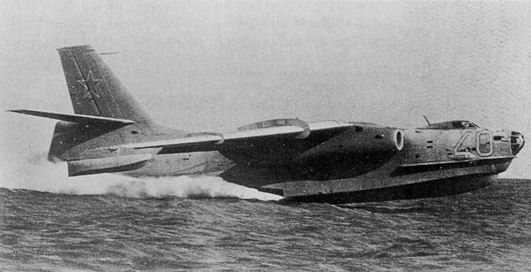
After the first flight test on the wing of the Be-10 appeared impressive aerodynamic partitions. Developers had to work hard, to prevent water from entering the air intakes TRD.
Accidents and Disasters
25 May 1961 year crashed in the Rostov region, near Taganrog Be-10. killing 2 man. Immediately after separation from the water lost control and collided with the surface of the sea. The fuselage broke in two and burst into flames. The rear part of the vertically stood. error crew – a sharp increase in the angle of attack on the lack of separation speed. maybe, This was due to accidental operation of the system rollback pilot's seat during the run.
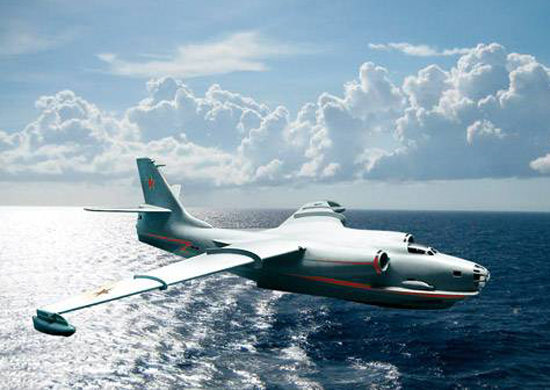
Performance characteristics of Be-10
– years of production: 1958 — 1961
– units produced: 27
The crew of the Be-10
– 3 human
The dimensions of the Be-10
– Wingspan: 22,3 m
– Length of the plane: 33,1 m
– Aircraft height: 11,03 m
– wing area: 111,8 m²
– Sweep angle of the wing: 35°
All Be-10
– Empty weight: 24 100 kg
– Mass normal takeoff: 45 000 kg
– Maximum take-off mass: 48 500 kg
Engine BE-10
– engine's type: 2 Various Lhuillier HE-7PB
– pull: 2 × 7500 kgf
Be-10 speed
– full speed: 880 kmh
– Cruising speed: 800 kmh
The flight range of the Be-10
– Ferry range: 4810 km
– practical range: 2960 km
Practical ceiling Be-10
– 12500 m
Armament Be-10
– four 23 mm NS-23 cannon
– combat load: to 3300 kg payload compartment (torpedo, bombs)
Photo was-10
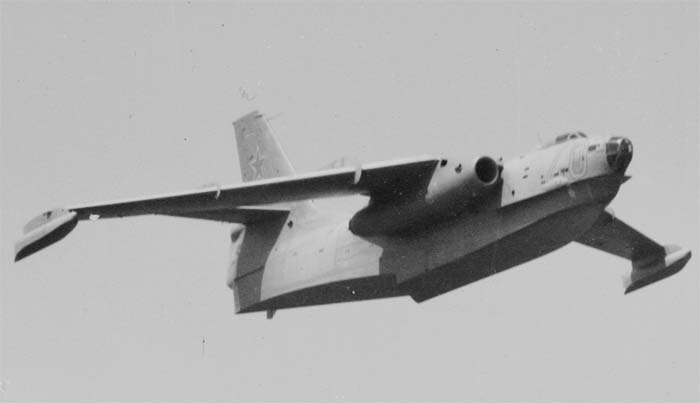
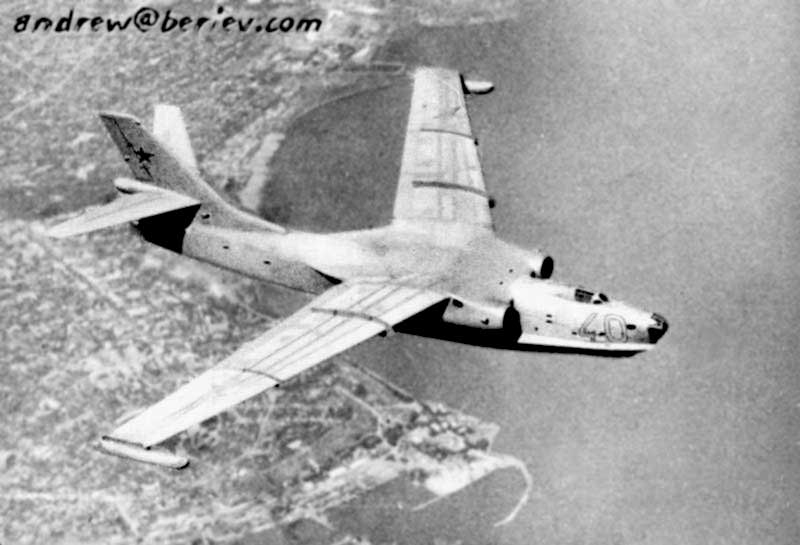
Record Be-10 in flight over Taganrog
